Wood Duck drake, Aix sponsa.
Image appears here with the kind permission of the photographer, Arthur Morris, Birds as Art.
Birds in Science
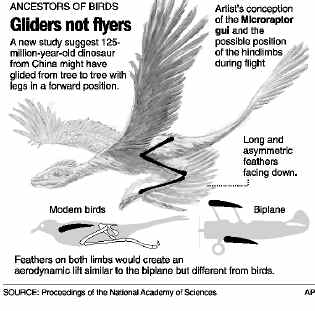 The ancestors of modern birds are thought to have been small, feathered, dinosaurs, the theropods. One of these small feathered dinosaurs is Microraptor gui, a feathered dromaosaur that lived 125 million years ago in what is now China. According to the evidence, Microraptor gui was one of the earliest gliders. But unlike modern birds, it appears to have utilized four wings, like a biplane, because it had long and asymmetric flight feathers on both its hands and feet.
The ancestors of modern birds are thought to have been small, feathered, dinosaurs, the theropods. One of these small feathered dinosaurs is Microraptor gui, a feathered dromaosaur that lived 125 million years ago in what is now China. According to the evidence, Microraptor gui was one of the earliest gliders. But unlike modern birds, it appears to have utilized four wings, like a biplane, because it had long and asymmetric flight feathers on both its hands and feet.
University of Florida paleontologist Bruce MacFadden said his team has determined that a prehistoric 7 foot tall flightless "terror bird," Titanis walleri, arrived in North America from South America long before a land bridge connected the two continents. Titanis walleri was carnivorous, weighed approximately 330 pounds, had powerful feet and a head larger than a man's. It is known in the fossil record from a single toe bone found in Texas, and in Florida from approximately 40 bone fragments from different parts of the bird's body. MacFadden's team also analyzed six specimens from the Santa Fe River in north Central Florida.
University of Vermont scientist Bernd Heinrich wondered what kinglets were eating in the winter to keep the metabolic flame burning. He found that although they are fairly opportunistic, eating everything from spiders to insect eggs, they subsist primarily on moth caterpillars found over-wintering on trees. He collected some of the caterpillars and kept them in his freezer for the rest of the winter. In the spring, he took them out and thawed them, then raised them to adulthood so that they could be identified more readily. They turned out to be one-spotted variants, a well-known moth whose over-wintering spot had not previously been known.
People Helping Birds
Proceeds from sales of Cerulean Warbler Conservation Coffee will help protect a rare songbird's habitat in Central Colombia says the American Bird Conservancy. The conservancy teamed up with Colombian partner Fundacion ProAves and the local growers' cooperative COOPERAN as well as the American Birding Association and the Thanksgiving Coffee Co. to bring the coffee project to fruition. Conservancy President George Fenwick said this warbler is North America's "fastest declining neotropical migratory songbird."
Conservationists have hailed Madagascar's decision to establish a 300,000 hectare (741,300 acres) protected habitat for birds unique to the giant Indian Ocean island. "One of Madagascar's most spectacular wildlife areas -- almost 3,000 square kilometres of tropical wetlands, forests, savannas and caves -- is to be protected by law," BirdLife International said in a statement.
A Southwest Victorian chicken farmer known as Swampy and his dog Oddball may have found a way to save some of Australia's endangered wildlife from predators. His four maremma sheepdogs had been protecting his chickens against predators for a decade. He figured they could do the same for the penguins. "The difficulty was trying to convince all the wildlife wallies to think outside the square," Marsh said. "It's not an altruistic view of penguins or chooks but an ingrained sense of territory that makes maremma dogs work, and it is far stronger in these dogs than any other domesticated breed."
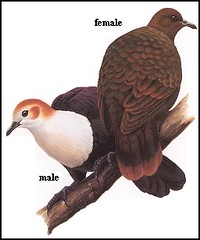 Two white-throated ground doves, Gallicolumba xanthonura (pictured, Image source), have hatched at the Louisville Zoo, the first births in captivity anywhere for the rare species, zoo officials announced Tuesday. The doves are native to the island of Saipan in Micronesia, where they have a very small range. Both young birds are doing well and will not be exhibited for at least a while longer, said zoo officials, who are monitoring the young doves from a remote location. "This is a dream come true ... really a thrill," said Gary Michael, the zoo's curator of birds, who developed the environment in the zoo's Forest Bird Trail Exhibit in the Islands Pavilion that was apparently conducive to the doves' mating.
Two white-throated ground doves, Gallicolumba xanthonura (pictured, Image source), have hatched at the Louisville Zoo, the first births in captivity anywhere for the rare species, zoo officials announced Tuesday. The doves are native to the island of Saipan in Micronesia, where they have a very small range. Both young birds are doing well and will not be exhibited for at least a while longer, said zoo officials, who are monitoring the young doves from a remote location. "This is a dream come true ... really a thrill," said Gary Michael, the zoo's curator of birds, who developed the environment in the zoo's Forest Bird Trail Exhibit in the Islands Pavilion that was apparently conducive to the doves' mating.
Wildlife conservation in Iraq has been given a significant boost with the release of a guide to Iraq's birds - the first field-guide of its kind for the nation. Covering the 387 bird species that have been recorded in Iraq, this is the first comprehensive, fully-illustrated field-guide to an Arabic-speaking country. "For Iraq - a nation that has lost so much of its wildlife in the last twenty years, this book opens the door for the growing conservation movement in this country." said Dr Ali Douabul of Nature Iraq. "Local language field guides are crucial tools for conservation. They encourage people to realise, appreciate and get involved in bird conservation, which, because birds are good indicators of the environment, has potential benefits for all of our wildlife."
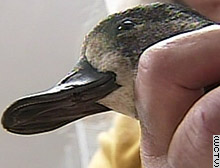 The ring-necked duck, Aythya collaris (pictured), survived being shot and spending two days in a hunter's refrigerator -- and now she's had a close brush with death on a veterinarian's operating table. The one-pound female duck stopped breathing Saturday during surgery to repair gunshot damage to one wing, said Noni Beck of the Goose Creek Wildlife Sanctuary. Veterinarian David Hale revived the bird after several tense moments by performing CPR.
The ring-necked duck, Aythya collaris (pictured), survived being shot and spending two days in a hunter's refrigerator -- and now she's had a close brush with death on a veterinarian's operating table. The one-pound female duck stopped breathing Saturday during surgery to repair gunshot damage to one wing, said Noni Beck of the Goose Creek Wildlife Sanctuary. Veterinarian David Hale revived the bird after several tense moments by performing CPR.
People Hurting Birds
Nearly half of the world's water bird species are in decline, mostly because of rapid economic development and the effects of climate change, according to a global survey released this week. The fourth Waterbird Population Estimate found that 44 percent of the 900 species globally have fallen in the past five years, while 34 percent were stable and 17 percent rising. The worst decreases occurred in Asia, where 62 percent of the water bird populations had declined or are now extinct. That was followed by a 48 percent decline in Africa, 45 percent in Oceania, 42 percent in South America, 41 percent in Europe and 37 percent in North America.
A group of renowned biologists say if nothing's done, birds could go extinct 50 times faster, eliminating about 1,200 species by century's end. The reasons: habitat destroyed by development, global warming and invasive species -- especially your cat. "If we lose species -- parrots, toucans -- our world will be a poorer place," said Stuart Pimm, a conservation biologist at Duke University. His fears are supported by a U.S. study, released just last week, that showed 30 North American shorebird species on pace to decline by 36 percent in the next 20 years.
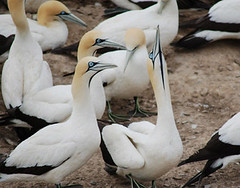 The beautiful Malgas, or Cape Gannet, Morus capensis (pictured, image source), an iconic species of the local coastline that has lent its name to places like Malgas Island in Saldanha Bay and the village on the Breede River, is in trouble. The gannet is one of three endemic seabirds that occur naturally only on the Cape and southern Namibian coasts (the others being the African Penguin and the Cape Cormorant), and it breeds at just six sites, three each in South Africa and Namibia. In an article titled "Going, going Gannet ...", Peter Ryan, an associate professor at UCT's FitzPatrick Institute of African Ornithology, explains why the gannets - and also the penguins and cormorants - are in a major biological crisis. A purse-seine fishery competes directly with these birds for pelagic fish such as sardines (pilchards) and anchovies, and over-fishing in the 1970s caused sardine stocks to collapse, says Ryan.
The beautiful Malgas, or Cape Gannet, Morus capensis (pictured, image source), an iconic species of the local coastline that has lent its name to places like Malgas Island in Saldanha Bay and the village on the Breede River, is in trouble. The gannet is one of three endemic seabirds that occur naturally only on the Cape and southern Namibian coasts (the others being the African Penguin and the Cape Cormorant), and it breeds at just six sites, three each in South Africa and Namibia. In an article titled "Going, going Gannet ...", Peter Ryan, an associate professor at UCT's FitzPatrick Institute of African Ornithology, explains why the gannets - and also the penguins and cormorants - are in a major biological crisis. A purse-seine fishery competes directly with these birds for pelagic fish such as sardines (pilchards) and anchovies, and over-fishing in the 1970s caused sardine stocks to collapse, says Ryan.
When kites jostled for space in the skies, little did one imagine that it will leave a trail of dead and injured birds including the endangered species of vultures. An animal welfare organization in the city has received over 700 birds injured by kite-strings during Uttarayan, which is celebrated as the festival of kites in the State. "We came here as we knew that a large number of birds, including a number of vultures, get seriously injured during the kite flying season in Gujarat," Andrew said. He is accompanied by his wife Dr Sorn Routh and an expert bird-handler from London zoo Natalie Reed.
Avian Influenza
"Flu" mistakenly has become a general, catch-all phrase for people who have a virus they believe to be worse than a common cold but not pneumonia. If, however, they're still able to walk around, there's a good chance it is not influenza, commonly shortened to flu. Semantics, you say? Maybe, but understanding the difference helps us better understand the possibilities of infecting our family, friends and work colleagues and how to better take care of ourselves. Cold, flu and pneumonia should not be interchangeable words. Each has a specific diagnosis. GrrlScientist note: I've written about this topic before, in fact. But as a bird-owner and bird-lover who has had the flu twice in my life, I can tell you that misusing the word "flu" as a catch-all for any unpleasant illness really bothers me -- a LOT -- because a real flu is an unforgettable and completely miserable experience.
The United Nations Food and Agriculture Organisation (FAO) has reported resurgence of the dreaded avian influenza in at least eight countries in Asia and Africa, and has urged all nations to remain vigilant and fully cooperate with international organisations in keeping this menace under check. Even though the flu is under control in Europe and America, the FAO has stressed that the virus persists in several Asian countries as well as in Egypt and Nigeria. Other countries may also have it but have yet to declare.
Indonesia, which has the world's highest number of human fatalities from bird flu, has been trying to step up efforts to stamp out the disease after a flare up in cases this year following a brief lull. "Even though our continued effort is giving some significant progress, we are still on highest alert," Welfare Minister Aburizal Bakrie said at a ceremony to receive 100,000 sets of protective equipment donated by the United States. Bakrie said the government had succeeded in containing human infections of bird flu in nine of the 30 high-risk provinces. The disease, however, remains endemic in fowl in some of the most densely populated parts of Indonesia, including Java.
The highly virulent H5N1 strain of the bird flu virus was confirmed yesterday by the agriculture ministry in the second case in a month in southern Japan's Miyazaki Prefecture.
The ministry confirmed the virus was the H5 variety on Thursday. The government of the prefecture decided on Friday to cull 5,000 chickens at the virus-hit Sato Broiler farm in the city of Hyuga and cull another 5,000 chickens on a farm adjacent to it as prevention measure.
Russia and Ukraine closed their borders to Hungarian poultry products on Friday, joining Serbia and Croatia, which had imposed a ban earlier this week amid fears of bird flu spread, Hungary's news agency MTI reported. Romania's animal hygiene and food safety authority announced on Friday that it would abide by a European Union decision to limit poultry imports from Hungary to the actual area where bird flu was discovered earlier this week, and would not introduce further restrictions.
Bird Festivals & Birding
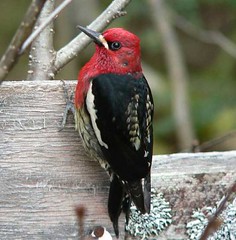 Bird-watchers from around the country gathered in southwestern Utah this past weekend to participate in the St. George Winter Bird Festival. The annual event, in its fourth year, is expected to draw about 1,300 people to Washington County to take part in free workshops, field trips and speeches about the feathered creatures. "Yesterday we saw a red-breasted sapsucker," said Hal Robins, who traveled from Salt Lake City with his wife, adding that the bird usually lives in coastal areas and is out of place in Utah. "It got us birders pretty excited." (pictured, image source).
Bird-watchers from around the country gathered in southwestern Utah this past weekend to participate in the St. George Winter Bird Festival. The annual event, in its fourth year, is expected to draw about 1,300 people to Washington County to take part in free workshops, field trips and speeches about the feathered creatures. "Yesterday we saw a red-breasted sapsucker," said Hal Robins, who traveled from Salt Lake City with his wife, adding that the bird usually lives in coastal areas and is out of place in Utah. "It got us birders pretty excited." (pictured, image source).
To judge from the commotion outside a Grand Rapids office building last weekend, one might guess that something special was happening. People stood in groups with binoculars looking toward the woods hoping to see something unusual -- a black-throated gray warbler, Dendroica nigrescens -- almost never seen in the Midwest. The tiny bird flitted in and out of the trees. It is thought that the warbler was blown off its migratory course by a winter storm. That it was in Grand Rapids rather than Mexico was nothing short of amazing.
Streaming Birds
 This week on BirdNote, for the week of January 29, 2007: Monday, sounds from the Amazon; Tuesday, why blackbirds are black; Wednesday, Bald Eagles' winter feast, with a note about the Upper Skagit Bald Eagle Festival, February 3rd and 4th; Thursday, birders and hunters -- and wetlands conservation; Friday, Nisqually National Wildlife Refuge and a BirdNote field trip on February 3rd. BirdNotes transport the listener out of the daily grind with two-minute vignettes that incorporate the rich sounds of birds provided by Cornell University and by other sound recordists, with photographs and written stories that illustrate the interesting -- and in some cases, truly amazing -- abilities of birds. Some of the shows are Pacific Northwest-oriented, but many are of general interest. BirdNote can be heard live, Monday through Friday, 8:58-9:00AM in Western Washington state and Southern British Columbia, Canada, on KPLU radio and now also in North Central Washington state on KOHO radio. All episodes are available in the BirdNote archives, both in written transcript and mp3 formats, along with photographs. Listener ideas and comments are welcomed. [rss].
This week on BirdNote, for the week of January 29, 2007: Monday, sounds from the Amazon; Tuesday, why blackbirds are black; Wednesday, Bald Eagles' winter feast, with a note about the Upper Skagit Bald Eagle Festival, February 3rd and 4th; Thursday, birders and hunters -- and wetlands conservation; Friday, Nisqually National Wildlife Refuge and a BirdNote field trip on February 3rd. BirdNotes transport the listener out of the daily grind with two-minute vignettes that incorporate the rich sounds of birds provided by Cornell University and by other sound recordists, with photographs and written stories that illustrate the interesting -- and in some cases, truly amazing -- abilities of birds. Some of the shows are Pacific Northwest-oriented, but many are of general interest. BirdNote can be heard live, Monday through Friday, 8:58-9:00AM in Western Washington state and Southern British Columbia, Canada, on KPLU radio and now also in North Central Washington state on KOHO radio. All episodes are available in the BirdNote archives, both in written transcript and mp3 formats, along with photographs. Listener ideas and comments are welcomed. [rss].
Birdbrained? Who says? Most people either think all birds are stupid or that they carry bird flu. However, a 17 year-old Indian Ring-necked parrot, Psittacula krameri, named AJ visited Martha Stewart on her show to show her a few tricks, such as playing golf and basketball [streaming video].
Miscellaneous Birds
After the Hilton Pond naturalists' discussion last week about bird skulls, they received several e-mails and calls asking why they hadn't included a hummingbird. So for installment #345 of "This Week at Hilton Pond" they do just that, concentrating on the amazing attributes of the skull and skeleton of a Ruby-throated Hummingbird. As always, they include a tally of birds banded and a list of significant recaptures (we caught a White-throated Sparrow, Zonotrichia albicollis, that's closing in on the known longevity record for its species), plus a few miscellaneous nature notes.
When John Lege was a boy in the 1950s, he got a kick out of watching his great-aunt's parakeet perch on her head and on her clothesline as she hung laundry. Even when the bird was outside, it never flew away. The interaction thrilled young John, who said he often was teased by classmates for his bird-watching. By the time he was in high school, he had saved nearly $200, enough to buy a parrot that a logger had rescued from a rain forest. Now, Mr. Lege conducts educational exotic bird presentations.
More news about those common grackles, Quiscalus quiscula, that died en masse in Austin, Texas. So what do you think now? Was this a murder most fowl, or a mass death that occurred die to parasites and a sudden drop in temperatures combined with not feeding in the past 24-36 hours?
.
The Fine Print: Thanks to Ian, Jeremy and Ron for sending story links. Thanks in advance to Ian for catching my typos; as you probably know by now, I put a few typographical errors in these documents just so Ian can find them! The featured image appears here with the kind permission of the photographer, so please contact him if you also wish to purchase this or other of his images. Other images are resized and are either linked from the news story that they accompany or they are credited and linked back to the photographer.
What is the point of Birds in the News? I publish BITN each week because I want to increase people's awareness of the importance of birds in our everyday lives. Birds represent many things to us; beauty, freedom, music, wildness. But everywhere, birds are coming under increasing pressure for their very survival, and by linking to news stories about birds, I hope to make the smallest impression upon the public and the mainstream media, as well as our decision-makers, that birds are an important feature of our everyday lives, that there are so many reasons that we could not do without them.
tags: Birds in the News, ornithology, birds, avian, newsletter
- Log in to post comments

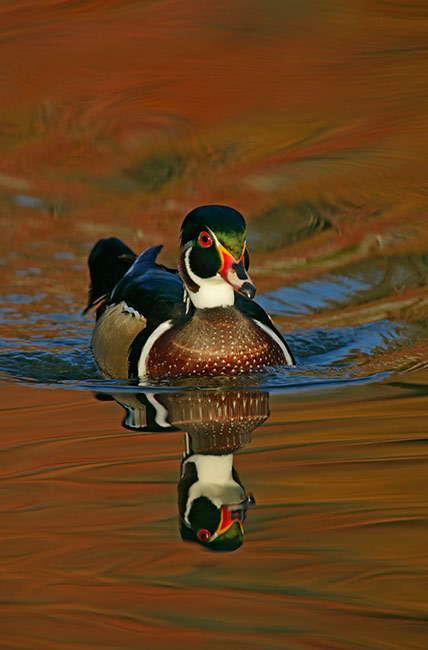

If possible could you please include an announcement regarding the Parrots International Symposium 2007 in your next blog....possibly in the "people helping birds". The Symposium may be of interest to some of your readers.
The PI Symposium is the largest annual parrot conservation conference in the world. The Symposium is co-sponsored by the UCLA Institute of the Environment and the UCLA Center for Tropical Research. The Symposium, held April 28 & 29, benefits parrot conservation and field research:
http://www.parrotsinternational.org/Symposium_2007/Symposium_2007_Main_…
The Symposium is a reflection of our mission statement regarding education and fostering international cooperation for the conservation of endangered parrot species. Parrots International supported projects can be viewed at:
http://www.parrotsinternational.org/Projects/projects_page_1.htm
All the best,
Mark Stafford
President, Parrots International
All the best,
Mark Stafford
President, Parrots International
as usual, a fine and informative newsletter... thank you!
Excellent as always.